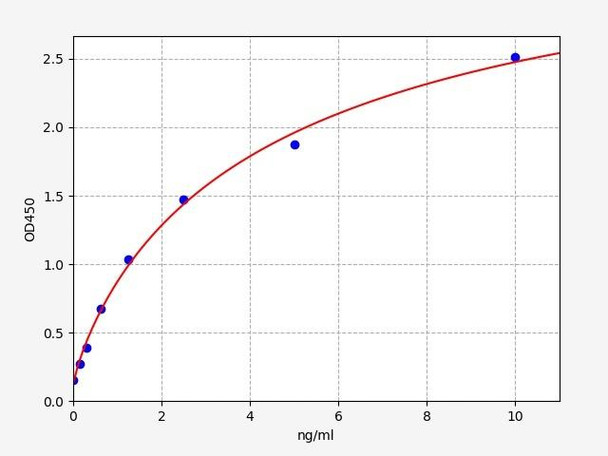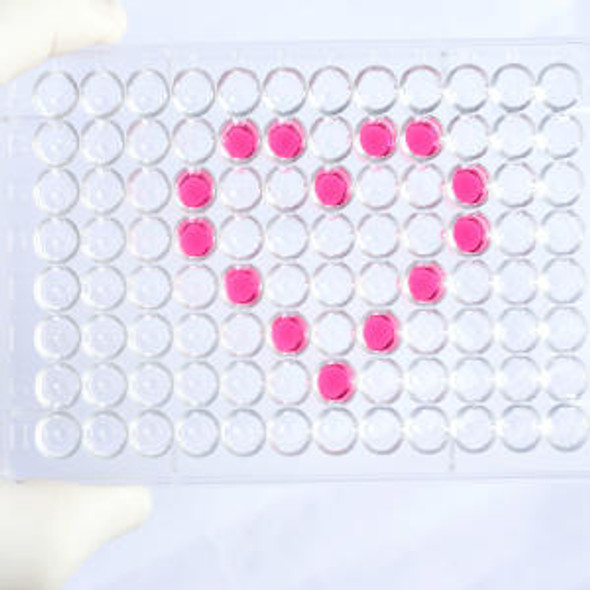Rat STAT3 ELISA Kit
- SKU:
- RTFI00096
- Product Type:
- ELISA Kit
- Size:
- 96 Assays
- Uniprot:
- P52631
- Sensitivity:
- 0.094ng/ml
- Range:
- 0.156-10ng/ml
- ELISA Type:
- Sandwich ELISA, Double Antibody
- Synonyms:
- Stat3, Signal transducer and activator of transcription 3
- Reactivity:
- Rat
Description
| Product Name: | Rat Stat3 (Signal transducer and activator of transcription 3) ELISA Kit |
| Product Code: | RTFI00096 |
| Size: | 96 Assays |
| Target: | Rat Stat3 |
| Alias: | Stat3, Signal transducer and activator of transcription 3 |
| Reactivity: | Rat |
| Detection Method: | Sandwich ELISA, Double Antibody |
| Sensitivity: | 0.094ng/ml |
| Range: | 0.156-10ng/ml |
| Storage: | 4°C for 6 months |
| Note: | For Research Use Only |
| Recovery: | Matrices listed below were spiked with certain level of Rat Stat3 and the recovery rates were calculated by comparing the measured value to the expected amount of Rat Stat3 in samples. | ||||||||||||||||
| |||||||||||||||||
| Linearity: | The linearity of the kit was assayed by testing samples spiked with appropriate concentration of Rat Stat3 and their serial dilutions. The results were demonstrated by the percentage of calculated concentration to the expected. | ||||||||||||||||
| |||||||||||||||||
| Intra-Assay: | CV <8% | ||||||||||||||||
| Inter-Assay: | CV <10% |
| Uniprot: | P52631 |
| UniProt Protein Function: | STAT3: transcription factor of the STAT family. Phosphorylated and activated by receptor-associated kinases downstream of many cytokines and growth-factor receptors. Constitutively active in a number of human tumors. Forms homo- or heterodimers that translocate into the nucleus where they regulate transcription. Two alternatively spliced isoforms have been described. |
| UniProt Protein Details: | Protein type:DNA-binding; Motility/polarity/chemotaxis; Nuclear receptor co-regulator; Transcription factor Chromosomal Location of Human Ortholog: 10q31 Cellular Component: cytoplasm; cytosol; mitochondrial inner membrane; mitochondrion; nuclear chromatin; nucleoplasm; nucleus; plasma membrane Molecular Function:CCR5 chemokine receptor binding; chromatin DNA binding; DNA binding; glucocorticoid receptor binding; identical protein binding; ligand-dependent nuclear receptor activity; protein binding; protein dimerization activity; protein kinase binding; protein phosphatase binding; sequence-specific DNA binding; transcription factor activity; transcription factor binding Biological Process: acute-phase response; aging; astrocyte differentiation; cell proliferation; cellular response to hormone stimulus; eating behavior; eye photoreceptor cell differentiation; glucose homeostasis; intracellular receptor-mediated signaling pathway; JAK-STAT cascade; leptin-mediated signaling pathway; miRNA-mediated gene silencing, negative regulation of translation; mRNA transcription from RNA polymerase II promoter; negative regulation of apoptosis; negative regulation of cell proliferation; negative regulation of glycolysis; phosphorylation; positive regulation of cell proliferation; positive regulation of Notch signaling pathway; positive regulation of transcription from RNA polymerase II promoter; positive regulation of transcription, DNA-dependent; protein import into nucleus; radial glial cell differentiation; regulation of cell cycle; regulation of mitochondrial membrane permeability; regulation of multicellular organism growth; regulation of transcription from RNA polymerase II promoter; regulation of transcription, DNA-dependent; response to cytokine stimulus; response to drug; response to estradiol stimulus; response to ethanol; response to organic cyclic substance; response to organic substance; response to peptide hormone stimulus; sexual reproduction; stem cell maintenance; thermoregulation; transcription from RNA polymerase II promoter |
| NCBI Summary: | transcription factor that plays a role in induction of gene expression during acute phase response [RGD, Feb 2006] |
| UniProt Code: | P52631 |
| NCBI GenInfo Identifier: | 6981592 |
| NCBI Gene ID: | 25125 |
| NCBI Accession: | NP_036879.1 |
| UniProt Related Accession: | P52631 |
| Molecular Weight: | 88,040 Da |
| NCBI Full Name: | signal transducer and activator of transcription 3 |
| NCBI Synonym Full Names: | signal transducer and activator of transcription 3 |
| NCBI Official Symbol: | Stat3 |
| NCBI Protein Information: | signal transducer and activator of transcription 3 |
| UniProt Protein Name: | Signal transducer and activator of transcription 3 |
| Protein Family: | Signal transducer and activator of transcription |
| UniProt Gene Name: | Stat3 |
| Step | Procedure |
| 1. | Set standard, test sample and control (zero) wells on the pre-coated plate respectively, and then, record their positions. It is recommended to measure each standard and sample in duplicate. Wash plate 2 times before adding standard, sample and control (zero) wells! |
| 2. | Aliquot 0.1ml standard solutions into the standard wells. |
| 3. | Add 0.1 ml of Sample / Standard dilution buffer into the control (zero) well. |
| 4. | Add 0.1 ml of properly diluted sample ( Human serum, plasma, tissue homogenates and other biological fluids.) into test sample wells. |
| 5. | Seal the plate with a cover and incubate at 37°C for 90 min. |
| 6. | Remove the cover and discard the plate content, clap the plate on the absorbent filter papers or other absorbent material. Do NOT let the wells completely dry at any time. Wash plate X2. |
| 7. | Add 0.1 ml of Biotin- detection antibody working solution into the above wells (standard, test sample & zero wells). Add the solution at the bottom of each well without touching the side wall. |
| 8. | Seal the plate with a cover and incubate at 37°C for 60 min. |
| 9. | Remove the cover, and wash plate 3 times with Wash buffer. Let wash buffer rest in wells for 1 min between each wash. |
| 10. | Add 0.1 ml of SABC working solution into each well, cover the plate and incubate at 37°C for 30 min. |
| 11. | Remove the cover and wash plate 5 times with Wash buffer, and each time let the wash buffer stay in the wells for 1-2 min. |
| 12. | Add 90 µL of TMB substrate into each well, cover the plate and incubate at 37°C in dark within 10-20 min. (Note: This incubation time is for reference use only, the optimal time should be determined by end user.) And the shades of blue can be seen in the first 3-4 wells (with most concentrated standard solutions), the other wells show no obvious color. |
| 13. | Add 50 µL of Stop solution into each well and mix thoroughly. The color changes into yellow immediately. |
| 14. | Read the O.D. absorbance at 450 nm in a microplate reader immediately after adding the stop solution. |
When carrying out an ELISA assay it is important to prepare your samples in order to achieve the best possible results. Below we have a list of procedures for the preparation of samples for different sample types.
| Sample Type | Protocol |
| Serum: | If using serum separator tubes, allow samples to clot for 30 minutes at room temperature. Centrifuge for 10 minutes at 1,000x g. Collect the serum fraction and assay promptly or aliquot and store the samples at -80°C. Avoid multiple freeze-thaw cycles. If serum separator tubes are not being used, allow samples to clotovernight at 2-8°C. Centrifuge for 10 minutes at 1,000x g. Removeserum and assay promptly or aliquot and store the samples at-80°C. Avoid multiple freeze-thaw cycles. |
| Plasma: | Collect plasma using EDTA or heparin as an anti-coagulant. Centrifuge samples at 4°C for 15 mins at 1000 — g within 30 mins of collection. Collect the plasma fraction and assay promptly or aliquot and store the samples at -80°C. Avoid multiple freeze-thaw cycles.Note: Over haemolysed samples are not suitable for use with this kit. |
| Urine & Cerebrospinal Fluid: | Collect the urine (mid-stream) in a sterile container, centrifuge for 20 mins at 2000-3000 rpm. Remove supernatant and assay immediately. If any precipitation is detected, repeat the centrifugation step. A similar protocol can be used for cerebrospinal fluid. |
| Cell Culture Supernatant: | Collect the cell culture media by pipette, followed by centrifugation at 4°C for 20 mins at 1500 rpm. Collect the clear supernatant and assay immediately. |
| Cell Lysates: | Solubilize cells in lysis buffer and allow to sit on ice for 30 minutes. Centrifuge tubes at 14,000 x g for 5 minutes to remove insoluble material. Aliquot the supernatant into a new tube and discard the remaining whole cell extract. Quantify total protein concentration using a total protein assay. Assay immediately or aliquot and store at ≤ -20°C. |
| Tissue Homogenates: | The preparation of tissue homogenates will vary depending upon tissue type. Rinse tissue with 1X PBS to remove excess blood & homogenizein 20ml of 1X PBS (including protease inhibitors) and store overnight at ≤ -20°C. Two freeze-thaw cycles are required to break the cell membranes. To further disrupt the cell membranes you can sonicate the samples. Centrifuge homogenates for 5 mins at 5000xg. Remove the supernatant and assay immediately or aliquot and store at -20°C or-80°C. |
| Tissue Lysates: | Rinse tissue with PBS, cut into 1-2 mm pieces, and homogenize with a tissue homogenizer in PBS. Add an equal volume of RIPA buffer containing protease inhibitors and lyse tissues at room temperature for 30 minutes with gentle agitation. Centrifuge to remove debris. Quantify total protein concentration using a total protein assay. Assay immediately or aliquot and store at ≤ -20 °C. |
| Breast Milk: | Collect milk samples and centrifuge at 10,000 x g for 60 min at 4°C. Aliquot the supernatant and assay. For long term use, store samples at -80°C. Minimize freeze/thaw cycles. |










